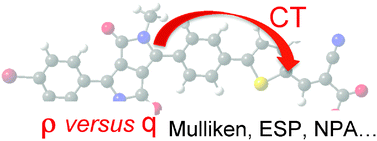We investigate the efficiency of several partial atomic charge models (Mulliken, Hirshfeld, Bader, Natural, Merz–Kollman and ChelpG) for investigating the through-space charge-transfer in push–pull organic compounds with Time-Dependent Density Functional Theory approaches. The results of these models are compared to benchmark values obtained by determining the difference of total densities between the ground and excited states. Both model push–pull oligomers and two classes of “real-life” organic dyes (indoline and diketopyrrolopyrrole) used as sensitisers in solar cell applications have been considered. Though the difference of dipole moments between the ground and excited states is reproduced by most approaches, no atomic charge model is fully satisfactory for reproducing the distance and amount of charge transferred that are provided by the density picture. Overall, the partitioning schemes fitting the electrostatic potential (e.g. Merz–Kollman) stand as the most consistent compromises in the framework of simulating through-space charge-transfer, whereas the other models tend to yield qualitatively inconsistent values.

You have access to this article
 Please wait while we load your content...
Something went wrong. Try again?
Please wait while we load your content...
Something went wrong. Try again?


 Please wait while we load your content...
Please wait while we load your content...